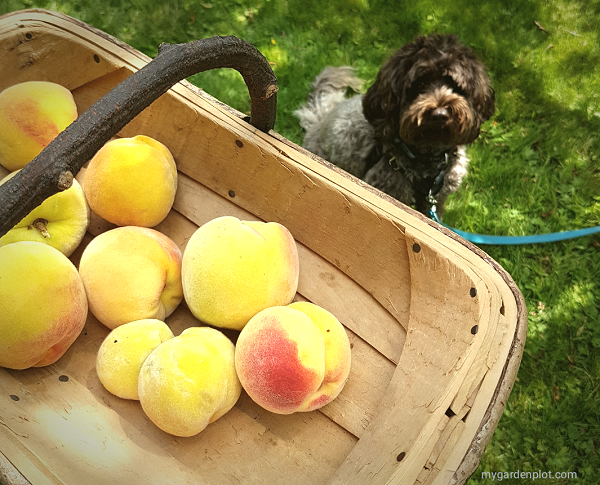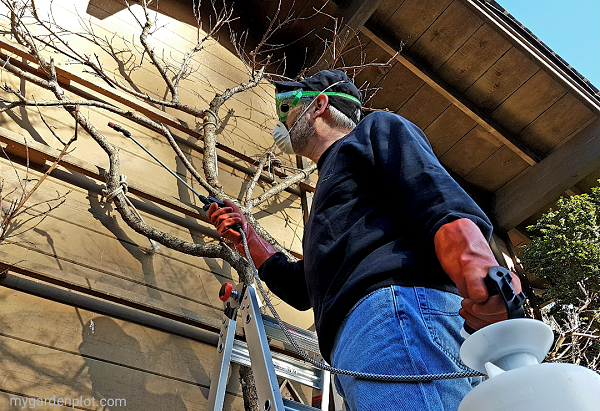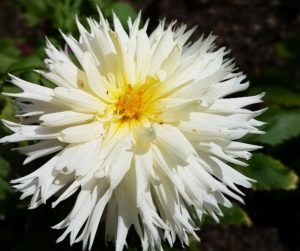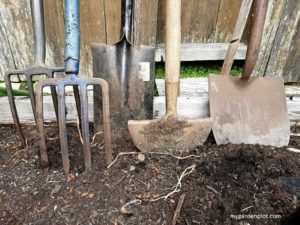Applying Dormant Spray (Horticultural Oil And Lime Sulphur) On Trees And Shrubs
With the preach tree now pruned for fruit production and ready for the next season, there is still the task to fit in with spraying the dormant oil solution by late winter. What is this? The dormant oil spray is a solution that helps kill overwintering pests, their eggs and diseases on trees and shrubs. Following is more information on using dormant spray in the garden, when and how to apply it, and what is needed with a dormant spray application.
It is worth noting that this solution should not be used on all plants. Some trees and shrubs are sensitive to this solution and should be excluded from dormant spray applications. These include Japanese maple, smokebush, cedar, and Japanese holly – a few of which we had in our garden and for which we needed to provide care when spraying nearby. Read more below on when and how to use dormant oil on ornamental and fruit trees and shrubs.
What is Dormant Spray?
Dormant spray is basically horticultural oil and lime sulphur. This can be purchased online or at your garden shop or DIY store. I prefer to use the dormant spray kit that consists of horticulture oil and lime sulphur liquids that you mix together with water at home. It is easy to prepare and apply in the garden. Follow the instructions on the dormant oil spray kit. If you purchase the horticultural oil and lime sulphur separately, mix 60 ml (4 tbsp) and 120 ml (8 tbsp) lime sulphur into 3 litres (just over .75 gallons) of water.
The dormant spray works by suffocating overwintering pests, such as aphids, spider mites, and scale, and their eggs nesting in branches; it is also recommended for peach leaf curl. It is also effective applied to some plants to control powdery mildew and rust plant disease that affected them the season before. Such as Hypericum (St John’s Wort), for which we have to apply dormant spray every winter to control the fungal rust disease that they are prone to get.
This solution is considered safe around humans and pets. Note that the solution can cause an allergic reaction or irritation with prolonged contact. Always wear protective goggles, respiratory mask and gloves when using dormant oil.
When And How To Apply Dormant Oil Spray
The dormant oil spray is applied during a tree or shrub’s dormancy while it is leafless and not in active growth. In the Pacific Northwest, spraying is generally best done in December and January, as February can be a wild card weather-wise. For ongoing control, schedule to apply at the end of autumn or beginning of winter, and again late winter. It is essential to apply the dormant spray before bud regrowth in the spring as it can damage green leaves on your plant.
The ideal weather conditions are also a necessary factor when using the dormant spray. The application should be done on a dry, warm day with above freezing temperatures during the day to be most effective. This allows the solution to thoroughly dry on the tree or shrub before any possible nighttime freezing weather.
What Is Needed For Dormant Oil Application
The following garden items are needed to apply dormant oil spray:
- Compression Pump Sprayer – Select a sprayer with a wand and adjustable nozzle. Shoulder straps help, too, especially if you need to climb a ladder.
- Protective Gloves
- Safety Goggles
- Protective Mask
- Step Ladder
- Dormant Oil Products – Our preference is for dormant spray kits with separate lime sulphur and horticultural oil that you mix at home. Though ready mixed solutions are also effective.
Dormant Oil Application: Remember to apply dormant oil spray before early spring. Once the leaf buds begin to grow and show green tips it too late. Spray in the morning on a dry, windless day that is at least over 5C (41F). The dormant oil application needs to dry before any chance of freezing at night.
West Coast Winter Weather And Our Homegrown Challenges
Well may you ask. The apparently simple task of spraying our peach tree was subject to a clear weather window of opportunity. Having left the job to January, after the peach tree was pruned, we soon realized this window of opportunity was becoming a challenge. Keep in mind that in southern British Columbia, we experienced one of the wettest Januarys on record. Waiting for a warm, dry day seemed elusive in our efforts.
However, mother nature did give us a sunny day one weekend. We dropped all plans and focused on spraying the peach tree and a few nearby shrubs. Alas, though sunshine and warmth were on our side, the wind was not. It was a mildly windy day. We nevertheless seized the day given. With the mixed dormant solution and our old garden sprayer ready, we started. We assessed the wind direction and worked with it as best as we could. Did we mention the dormant spray is stinky?
Donned with ill-fitting goggles, which fogged up with breathing, and our previous year’s old mask, seeing and breathing provided an added unexpected challenge. Not stopping short of what else could go wrong, the old sprayer developed a sticky trigger and would not stop immediately but carried on erratically until the frustrated operator called a halt. We would seem to me that it would have been best to go shopping first for a new compression sprayer, etc.
Regardless, with a little laughter along the way, this garden chore of applying the dormant spray to our preach tree was completed. And we were ready for another season of juicy peaches!

RELATED TOPIC: Common Pest Problems And Plant Diseases






